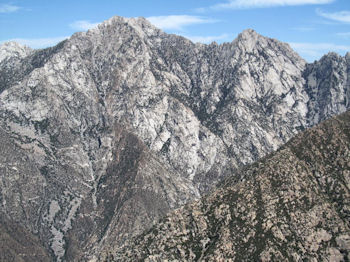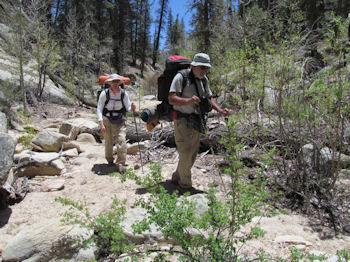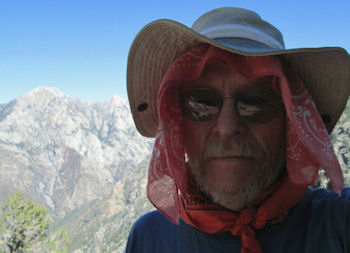 |  |

Northern Baja’s Sierra de San Pedro Mártir has long been a favorite summer destination of mine. Midday temperatures are usually in the 70s and 80s and very pleasant for hiking, though overnight temperatures can drop into the 30s and 40s, and dramatic lightning storms impact the mountains in July and August.
It is, of course, a Mexican national park, and there is an entrance fee – currently about US $4.25 per person a day, but you can buy an annual "passport" for under $30 that permits entrance to all the national parks of Mexico.
The road to the park from Highway One at San Telmo, has only recently been paved. Ten years ago the drive was a beautiful but tedious 50 miles of dust, washboard and rock.
With the better road more visitors come but, if you are planning on staying overnight, you need to bring all your own food, water, and everything necessary for camping at over 8,000 feet. Motorcycles are not allowed in the park.
Most of the "Parque Nacional Sierra de San Pedro Mártir" is on an undulating plateau with scattered granite outcrops and occasional open meadows poking through an old growth coniferous forest that has never known serious logging or fire suppression. There is a sameness about it in every direction. It is very easy to get lost.

Mexico’s national observatory is at the end of the road, at the east end of the park, on the edge of a spectacular 4,000 feet deep, V-shaped canyon – Canyon Diablo. And across the canyon, overlooking the San Felipe desert stands Baja’s highest mountain, Picacho del Diablo (10,154 feet).
Over a hundred years ago, adventurer and sportsman Arthur W. North described Picacho Diablo as:
"a mighty peak… [rising] high above the clouds, the jagged summit of all Baja California, the unchallenged retreat of lions and mountain sheep, the unscaled lookout of eagles and mighty condors. The glistening granite sides of this majestic peak glisten in the sun as though robed in purest snow and even from the banks of the Colorado, a hundred miles away, its jagged white pinnacle juts boldly above the skyline."
The condors have gone and been reintroduced, and since the first known ascent in 1911, hundreds of hardy souls have reached the summit, but otherwise the description holds true today.
I have often gazed at Picacho Diablo from the observatory and at places along the edge of Canyon Diablo. It has both intimidated and called me. Seeing it from the west, across the deep canyon which must first be traversed, it looks impossible to conquer without ropes and some serious climbing skills.

Even though I have spent dozens of hours studying it, photographing it, and appreciating its dramatic beauty, I only made my first attempt to climb it in May this year.
My companions were two tough old Baja adventurers - Ronnie Christian and Roger Jacobs - both in their 70s, both had experience attempting the climb before, but without reaching the peak. I was the youngster, ten years their junior.
As expected, the attempt didn’t go quite according to plan, but what a fantastic Baja adventure it turned out to be.
Roger, who lives in Ensenada, was good enough to let us leave our vehicles at his house. I came down from San Diego. Ronnie drove all the way from his home in Laredo, Texas for the attempt.
We arrived at the park May 23, and set out mid-morning Friday, May 24 to begin the long, heavy haul from the Padre Kino campsite and trailhead with a five-day supply of food and a few pints of water each.
We intended to camp on the rim of the canyon, four miles away, just below the summit of Botella Azul or Blue Bottle (9680 feet), the highest peak within the park boundary. Then next evening, we needed to be down in the bottom of Canyon Diablo, at Campo Noche, where there is a stream with pools and plenty of shade. As the name suggests, most climbers spend the night at Campo Noche, resting up for the assault on the summit.

Crossing the plateau was predictably tough going, with rugged, steep slopes and many fallen trees to deal with. As agreed, we settled on an easy pace to minimize risk of injury and we all knew the odds were long that we would make it all the way to the summit, and we might not even make it to Campo Noche.
Five hours or so into the attempt, at a spring before we reached Blue Bottle, we caught up with a party of Mexican hikers who were also en route to Picacho - April and May are prime months to attempt the climb. While they pushed on we filtered water and assessed our situation. Thinking about what we had passed through and the long, incredibly steep drop to the canyon bottom ahead, Roger reluctantly but wisely decided to abandon his quest, camp for the night by the spring and return to camp next morning.
Ronnie at 70 knew if he didn’t go for the summit now, it would probably never happen. So we agreed that he would continue and try to hook up with the Mexican party ahead, and I would return with Roger the next morning.
A couple of hours later, Ronnie made it all the way up to the Blue Bottle trailhead and met the group there who kindly agreed to let him join them. But after witnessing an injured would-be climber being assisted out of the canyon, and worried that he might slow down his much younger companions or cause an equal difficulty, he decided to race the night back to where Roger and I were camped.

It got dark before he found us and he had to make camp alone just a few hundred yards from where we were.
Ironically, at midnight that night, as we dozed by the light of a full moon, a couple of young Mexicans had set out from Padre Kino attempting to establish a record for the fastest climb of Picacho Diablo from the Kino campground. They had support crews waiting with food, water and medical supplies at Blue Bottle, at Campo Noche and up on Picacho. We all heard the two record chasers rushing by around 1 AM. What had taken us five hours to reach took them a little over an hour!
Luckily, Roger and I were in no hurry to leave next morning, and Ronnie wandered up just as we were finishing breakfast and packing up. In spite of our curtailed attempt on Picacho, it was a good feeling to be all back together… and then four hours later safely back at the vehicle.
We were there in time to applaud the record-setting duo’s triumphant afternoon return. They had traversed the canyon twice, scaled the summit and made it back to their starting point in just 15 hours and 25 minutes. Greeted by friends and family and "observers," there was quite a party with beer and wonderful food.
We were graciously invited to partake. The quesadillas and ceviche tostados were much appreciated after a couple of days subsisting on trail mix and cereal bars.

While Roger recovered and enjoyed a few less arduous hikes, Ronnie and I explored the edge of Canyon Diablo and peered wistfully over at the peak, examining the route we hoped to one day take. And just for a few moments we caught sight of a tiny figure standing tall on the summit. We guessed correctly it was one of the party that Ronnie nearly joined.
On our last day, Ronnie and I hiked to the top of Blue Bottle peak to further contemplate the route to Picacho and dream and scheme about another attempt, possibly in the fall.
Roger felt terrible about not going further but at least he had tried and did what he did, a fantastic achievement at 72. He was sensible enough to know his limits and take heed of what his legs were telling him.
And I felt privileged to camp in the peace of the Sierra San Pedro Mártir with two amazing Baja old-timers, listening to tales of Roger’s life as an agricultural inspector and Ronnie’s teaching and army service with the 82nd Airborne.
As they say, the journey is sometimes more important than the destination. It was a peak experience even if we didn’t make it to the top of Baja.
That pleasure still awaits.
About Graham
Graham is the author of four books on Baja California including Nearer My Dog to Thee which describes a four-month sojourn in the Sierra San Pedro Mártir with two adopted street dogs.
Details on all Graham’s books can be found on his website: www.grahammackintosh.com